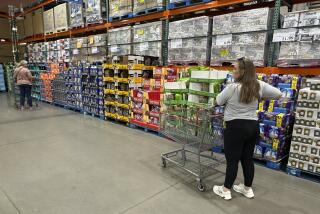Merchants report weak March sales
- Share via
U.S. retail sales were disappointing in March -- and people probably aren’t changing their spending habits this month.
“I don’t think April’s going to be any better,” Britt Beemer, chairman of America’s Research Group, said Thursday after the March numbers were released.
Sales fell 0.5% to $65.6 billion at stores open a year or more, according to the International Council of Shopping Centers’ tally of 37 national chains.
It was the weakest March in 13 years.
In the same month last year, there was a year-over-year gain of 5.9%.
“When you go through the details, it seems to be more of the same -- more of the economic impact -- and it’s widespread,” said Michael Niemira, the shopping center group’s chief economist. “The next question is, so when do we turn the corner.”
Analysts said they didn’t see the turn any time soon, which is worrying. Economists keep a sharp eye on consumers because their spending accounts for 70% of economic activity.
A variety of factors hurt retailers last month. Easter backed up into March, arriving when the weather was still chilly, so shoppers bypassed springtime clothing. Meanwhile, the housing market still is slumping, credit remains tight and gasoline and food prices keep rising. The job market also has weakened.
In March, apparel giant Gap Inc. suffered an 18% decline in sales, more than twice the drop analysts polled by Thomson Financial were expecting. The San Francisco-based parent of the Gap, Old Navy and Banana Republic chains saw sales fall in all divisions. Old Navy plunged 27%.
J.C. Penney Co. was another big loser, with sales sagging 12.3%, slightly more than expected. Declines were “broad-based across most merchandise categories and areas of the country,” the company said.
As a group, department stores suffered an 8.2% decline.
Shoppers also largely shunned luxury stores. Nordstrom Inc. saw sales drop 9.1%, 1.8 percentage points more than anticipated, while Saks Inc. logged a 2.9% decline, instead of the 3.5% gain analysts had predicted. Neiman Marcus edged up 0.4%.
April, a month in which tax refunds roll in, is typically when Americans make major purchases of items for their homes, such as appliances and carpeting, Beemer said. But his surveys this year show that 75% of tax refund dollars will go to pay bills or reduce debt. “There’s no money left to do these big-ticket items,” he said.
March had bright spots. Costco Wholesale Corp. and BJ’s Wholesale Club logged gains that beat expectations, 7% and 6%, respectively.
Wal-Mart Stores Inc. said its 1.1% gain was buoyed by solid sales in a variety of areas, including food, flat-panel TVs, and laptop computers. As a result, the company boosted its first-quarter profit projection for continuing operations to 74 cents to 76 cents a share from 70 cents to 74 cents.
Some California retailers didn’t fare as well. Sales at Pacific Sunwear of California Inc. in Anaheim fell 8%, instead of the 1.7% analysts were expecting. Foothill Ranch-based Wet Seal Inc. fell 10.8%, more than the anticipated 7.5%.
Although some retailers were feeling more upbeat about April, analyst Jharonne Martis at Thomson Financial said she expected the weak trends to continue, partly because of job losses. Consumers might not understand all the complex indicators, she said, but “one piece of data they really do understand is unemployment.”
--
More to Read
Inside the business of entertainment
The Wide Shot brings you news, analysis and insights on everything from streaming wars to production — and what it all means for the future.
You may occasionally receive promotional content from the Los Angeles Times.










